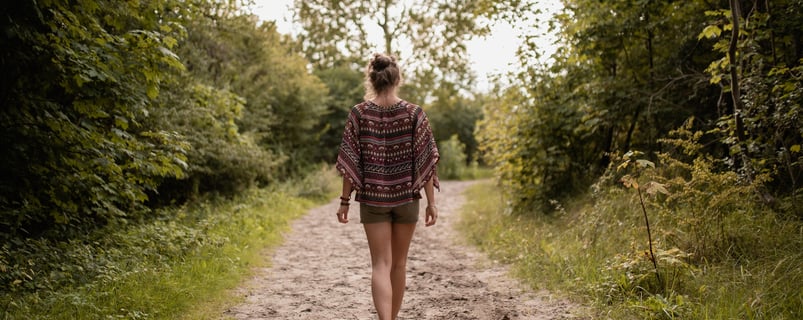Mindfulness for Beginners: A Step-by-Step Guide to Get Started
Start your mindfulness journey with this beginner-friendly guide. Learn practical steps to reduce stress and improve focus, even if you're short on time.
PERSONAL GROWTHSELF-CARE
10/21/20247 min read


Mindfulness for Beginners: A Fun, Friendly Guide to Finding Calm in Everyday Life
So, let’s get real—life can be a bit of a whirlwind. Between work, social commitments, scrolling through social media, and trying to remember where you left your keys, it’s easy to feel like you’re living on autopilot. The world’s moving a million miles an hour, and honestly, who couldn’t use a little calm and clarity?
Enter mindfulness. It’s that secret sauce that can help you slow down, breathe a little deeper, and find some calm amidst the chaos. But if you’re new to it, mindfulness might sound a little mysterious or even a tad intimidating. Does it mean sitting cross-legged for hours, trying to empty your mind? (Hint: Nope!)
Here’s the scoop: mindfulness isn’t about “clearing your mind” or “achieving zen” (though zen moments are definitely welcome). It’s about being present in the moment—fully and without judgment. Think of it as a way to hit pause on the rush, take a step back, and really savor what’s happening around you. We’re talking about tuning into that warm cup of coffee in the morning or actually listening when someone’s talking. Ready to give it a try? Let’s dive into the what, why, and how of mindfulness.
So, What Exactly Is Mindfulness?
At its heart, mindfulness is just paying attention—on purpose. It’s about focusing on what’s happening in the here and now, without getting lost in thoughts about yesterday or tomorrow. Imagine you’re savoring your morning coffee, actually noticing the smell, the warmth, and the taste, without scrolling through emails or planning your day. That’s mindfulness in action. It’s about slowing down and being fully present in the moment without judging what’s happening around you. That’s mindfulness. Simple, right?
Mindfulness is like giving your brain a break from its usual chatter about everything that needs to be done or rehashing things that happened last week. Instead, it’s training your mind to come back to the present moment. Why? Because being here, in the now, can help reduce stress, boost concentration, and make life feel a little fuller. Plus, it’s way less stressful than trying to predict the future or analyze the past.
Getting Started: A Beginner-Friendly Guide to Mindfulness
Alright, so how do you actually do mindfulness? Let’s ease in with some simple steps and fun exercises that’ll help you get a taste of this whole being-present thing.
Step 1: Start with the Basics (No Magic Required)
First things first—mindfulness isn’t about achieving some magical state of calm. (Wouldn’t that be nice, though?) Instead, it’s about noticing what’s going on, both around you and within you, without judgment. Got a mind full of thoughts? Great! That’s normal. Got a to-do list running through your brain? That’s fine too.
Think of mindfulness as an invitation to just notice. Notice the sounds, the smells, the thoughts, and even the distractions. It’s all about being aware. No need to fix or change anything. Just be curious and open to whatever comes up, even if it’s not particularly peaceful. Kind of takes the pressure off, right?
Step 2: Start Small—Think of It as Mindful “Snacks”
If you’re just starting out, you don’t need to dive into hour-long sessions or go on a retreat. Start with five minutes—just five! Think of it as a “mindfulness snack” that you can enjoy without too much commitment.
Find a quiet space where you can sit comfortably. You don’t need to sit cross-legged on the floor unless you really want to; a chair works just fine. Keep your back straight, shoulders relaxed, and close your eyes if that feels good. Just giving yourself a few quiet minutes can feel like a mini retreat from the usual rush of the day.
Step 3: Breathe, Baby, Breathe
Breathing might sound a little too simple, but focusing on your breath is actually one of the easiest ways to practice mindfulness. It’s like a built-in anchor that brings you back to the moment whenever your mind starts to wander (which it absolutely will, so no worries there).
Take a deep breath in through your nose, and then slowly let it out. Pay attention to how the air feels as it enters your nose, fills your lungs, and leaves your body. Notice the rise and fall of your chest or belly. When your mind starts doing its thing—wandering off to your grocery list or a random song lyric—just gently guide it back to your breath. No need to judge yourself; minds are built to wander!
Each time you bring your attention back to your breath, it’s like a little mental “rep.” Over time, these tiny moments of focus help train your mind to be a little more present, both in meditation and in everyday life.
Step 4: A Step-By-Step Body Scan
If sitting in silence feels a bit much, why not try a body scan? This exercise involves focusing on each part of your body, from head to toe (or toe to head—dealer’s choice). It’s super relaxing and perfect for anyone who tends to hold onto stress or tension.
Get Comfortable: Lie down on your back or sit in a comfy chair.
Start with Your Toes: Bring your attention to your toes. Notice any sensations, warmth, tingling, or maybe just a sense of nothingness. That’s all good—there’s no right answer here.
Work Your Way Up: Slowly move your attention up through your feet, ankles, calves, knees, thighs, and so on. Just notice each part, one at a time.
Release Any Tension: If you notice tension in any area, try to breathe into it and let it go. Imagine your breath softening and releasing any tight spots.
Finish at the Top of Your Head: When you reach your head, take a deep breath, let it out, and relax for a moment.
The body scan is amazing for reconnecting with yourself and noticing any areas of tension that you might not even realize you’re holding. It’s like a mini self-care session you can do anywhere, anytime.
Step 5: Walking with Awareness: The Art of Mindful Walking
For those who struggle to sit still (hi, me too!), mindful walking is a lifesaver. It’s a way to practice mindfulness on the move. You can take it outside or just walk slowly around your home—no gym required.
As you walk, pay attention to the sensations in your feet as they touch the ground. Notice the rhythm of your steps, the feeling of your body moving, and the sensation of your feet connecting with the earth. If you’re outside, take in the sights, sounds, and smells. Let yourself get curious about what’s around you.
When your mind starts to wander (and it will!), just gently bring it back to the feeling of walking. Mindful walking is perfect if you’re the type who finds it tough to sit still. Plus, it’s a great excuse to get outside and enjoy a bit of fresh air!
Step 6: Mindful Listening: Tuning Into the World Around You
If you’ve ever felt like life is passing you by, mindful listening might be the exercise for you. It’s simple but surprisingly powerful. Find a quiet place, sit comfortably, and just…listen. That’s it. You don’t need to analyze what you’re hearing or label the sounds—just tune in and notice.
You might hear birds chirping, cars driving by, or the hum of your fridge. The idea is to listen without judgment, letting each sound come and go. If thoughts pop up (and they definitely will), notice them, and then gently bring your focus back to listening.
Mindful listening sharpens your ability to focus, and it’s a lovely way to feel connected to the world around you. Plus, it gives your mind a much-needed break from all that thinking.
Common Mindfulness Pitfalls (and How to Get Past Them)
Starting a mindfulness practice can be a bit bumpy at first, especially when your mind feels like it’s everywhere but the present moment. Here’s a rundown of common challenges and how to work through them:
“My mind won’t stop wandering!”
Good news: this is completely normal! Minds are built to wander. The goal of mindfulness isn’t to have a blank mind; it’s to gently notice when your mind wanders and bring it back. Think of it like training a puppy—patience, not perfection!“I don’t have time for this!”
You don’t need to meditate for hours. Even five minutes can make a difference. Try incorporating mindfulness into small moments of your day, like while waiting for your coffee to brew or during your commute. It all adds up.“I feel restless sitting still.”
If sitting meditation isn’t your thing, don’t sweat it. Try mindful walking, eating, or even stretching. Mindfulness is flexible, so find what works best for you.
Easy Mindfulness Exercises to Try Anytime, Anywhere
Want to bring mindfulness into your daily life? Here are some simple exercises you can try whenever you have a moment:
Mindful Eating: Next time you eat, slow down and savor each bite. Notice the flavors, textures, and smells. It’s a delicious way to practice mindfulness and can even help curb overeating.
Gratitude Practice: Try starting or ending your day by thinking of three things you’re grateful for. It’s a lovely way to shift your focus to the positive and make mindfulness a daily habit.
Mindful Stretching: Take a few minutes to stretch, paying attention to the sensation in each muscle. Breathe deeply into each stretch, letting your breath guide you. It’s a great way to wake up in the morning or unwind at the end of the day.
Loving-Kindness Meditation: In this practice, you focus on sending positive thoughts to yourself and others. Start with yourself, repeating phrases like, “May I be happy, may I be healthy.” Gradually, send these thoughts to loved ones, acquaintances, and even people you find challenging. It’s like sending out little mental “good vibes.”
Wrapping It Up: Making Mindfulness a Daily Habit
So, there you have it—a beginner’s guide to mindfulness that’s as approachable as it is effective. Remember, mindfulness isn’t about becoming a perfectly serene guru. It’s about being a little more present, a little more aware, and a little kinder to yourself.
The real magic of mindfulness lies in its simplicity and flexibility. You can practice anywhere, anytime, in any way that feels good to you. Start small, experiment with different exercises, and let mindfulness become a natural part of your day. Over time, you’ll likely notice a boost in your mood, reduced stress, and maybe even a little more joy in the small moments. So why not give it a go? You just might find it’s the gentle reset you’ve been looking for.




